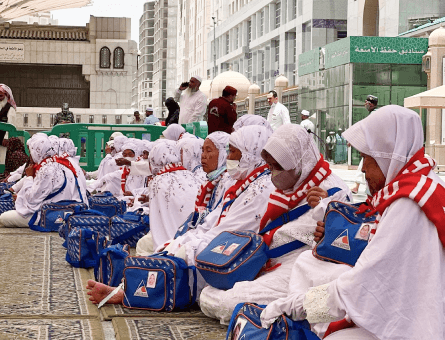Muhrim – Meaning, Rules & Differences Explained
In the Name of Allah—the Most Compassionate, Most Merciful.
Every Muslim reaches a moment in life when their heart yearns to perform Umrah or Hajj. And why not?
There’s a sense of peace associated with simply imagining being close to the Creator.
It’s an experience where the mental focus shifts from material distractions to spiritual refinement, and a moment that aligns the heart, mind, and actions with supreme purpose.
Well, it all begins with stepping into the sacred state of ihram.
Wearing Ihram is more than just putting on white clothes. It’s about entering a state where ordinary actions take on sacred weight.
And central to this moment is the identity of the Muhrim, the pilgrim in ihram.
Many Muslims, particularly first-time visitors, hear these terms but do not understand what it means to fully uphold this status or identity.
Hence, in this article, we’ll address the meaning and difference between the words ‘Muhrim’, ‘Ihram,’ and even ‘Mahram’.
We’ll answer the common questions that visitors normally have in their mind, and simplify what it really means to be a Muhrim, including the restrictions that come with this status.
What Is Muhrim in Islam?
A Muhrim is a person who enters the state ofihram for the purpose of performing Hajj or Umrah. This term applies to both men and women.
The moment a person makes the intention (niyyah) and dons the prescribed attire for ihram, they become a Muhrim.
“Zooming in, the word Muhrim (مُحْرِم) comes from the Arabic root ḥ-r-m, which relates to sacredness and prohibition.”
That’s why the Muhrim is someone for whom certain things that were previously permitted become forbidden, temporarily, out of reverence for this spiritual quest.
So, the Muhrim is not just a pilgrim; it’s a spiritual role with defined limits and deep responsibility.
What Is Ihram in Hajj and Umrah?
To gain a deeper understanding of the Muhrim, one must first understand ihram. Addressing the question, ihram is a sacred state a Muslim enters when intending to perform Hajj or Umrah.
For men, ihram involves wearing two unstitched white cloths; one is worn in a way that covers the waist to the knees (Izar), and the other is draped over the shoulder (Rida).
As all men wear the same white attire, this simple outfit signifies uniformity and equality. In simple words, when a Muhrim male stands alongside others in ihram, it strips him of any status or rank.
For women, there’s no special dress associated with the state of ihram, but it’s necessary for a woman to wear decent clothing and cover her head.
However, women are not allowed to cover their face and hands during ihram.
Apart from clothing, ihram also involves a spiritual intention that marks the beginning of the pilgrimage rites. Regarding intention, the Prophet Muhammad (صلى الله عليه وسلم) said:
(Source: Sunnah.com)
Hence, it’s the intention of entering into the state of ihram that transforms the person into a Muhrim.
What Is the Difference Between a Muhrim and Mahram?
We often hear a term ‘Mahram’ in Islamic context. This term sounds similar to ‘Muhrim’, especially in the context of pilgrimage, but it carries an entirely different meaning.
To clarify, a Muhrim is someone in the state of ihram. On the other hand, a Mahram is a close male relative a woman cannot marry due to blood, marriage, or breastfeeding ties.
According to the rules and regulations of the Saudi government, it was necessary for a woman to travel (for Umrah or Hajj) with a mahram.
However, For Umrah and Hajj, 2025, Saudi Arabia has officially lifted the requirement for women to be accompanied by a mahram.
This change allows women to participate in the pilgrimages independently, as long as they meet certain criteria, such as traveling with a recognized tour operator.
So, to simplify:
| Term | Meaning | Role in Pilgrimage |
| Muhrim | A person in the state of ihram | Must follow ihram rules during Hajj/Umrah |
| Mahram | A male relative a woman can’t marry | Must accompany a woman during travel (if needed) |
So, a man can be both a Muhrim and a Mahram, but the two terms are not interchangeable.
There’s also a term ‘Bukan Muhrim.’ In English, it translates to ‘non-mahram’ to emphasise the boundaries of interaction for women.
Forbidden Acts for Muhrims
Once a person becomes a Muhrim, several actions become forbidden until they exit the state of ihram.
These rules exist to protect the sacredness of the journey.
Below are the key forbidden acts for a Muhrim:
- Sexual relations and sexual intercourse
- Use of perfumes or products with scent
- Cutting hair or nails (cutting hair is only allowed after exiting ihram)
- Hunting land animals
- Wearing sewn garments (for men)
- Covering the head (for men) or face (for women)
- Marriage proposals or conducting marriage
- Engaging in quarrels or disputes
The list of prohibited acts for a Muhrim during Umrah or Hajj is derived from the Qur’an, Sunnah (Hadith), and the teachings reported by Abu Hurayrah, Ibn Uma, Ibn Abbas, and other companions.
FAQs
Here are some frequently asked questions that bring together key points already explored in this article. It’s a quick reference for readers finding concise answers.
Summary – Muhrim
To conclude, performing Umrah or Hajj are experiences that hold profound peace, and becoming a Muhrim is a commitment to enter a sacred state, follow divine restrictions, and carry out acts of worship with heightened consciousness.
So, if you are preparing for Hajj or Umrah, make sure you know the significance and obligations that come with becoming a Muhrim.
It will help you respect the sacredness of the ihram. After all, from avoiding forbidden things to knowing what a Muhrim wears, every detail shapes your inner and outer journey.















